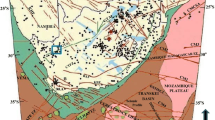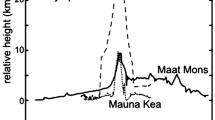Abstract
Neotectonism in the Sub-Himalayan belt is not new. Moreover, the word ‘Sub-Himalaya’ is almost synonymous with ‘neotectonic activity’. In the present paper, we report some of the most convincing geomorphic and structural evidences of neotectonic activity from the Sub-Himalayan belt in the Nahan Salient. The geomorphic evidences mainly include the four geomorphic surfaces identified from the transverse topographic profiles drawn parallel to the Himalayan front. These surfaces are commonly covered with terrace deposits that are tilted as well as faulted at a number of places. A number of faults, directly observable in the field, are normal in nature and they are oriented at high angles to the Himalayan Frontal Thrust (HFT). These faults are similar to the E-W extension in southern Tibet in response to the oblique convergence of India at ∼N20°E in the NW Himalaya. They are attributable to the kinematics of neotectonic compression along the HFT, the frontal ramp-oblique ramp-frontal ramp geometry of the thrust fault and related adjustments.
Similar content being viewed by others
References
Armijo, R., Tapponnier, P., Mercier, J.L. and T-L, H. (1986) Quaternary extension in the southern Tibet: field observations and tectonic implications. Jour. Geophys. Res., v.91, pp.13803–13872.
Delcaillau, B., Carozza, J.M. and Laville, E. 2006. Recent fold growth and drainage development: the Janauri and Chandigarh anticlines in Siwalik foothills, NW India. Geomorphology, v.76, pp.241–256.
Dubey, A.K. (1997) Simultaneous development of noncylindrical folds, frontal ramps, and transfer faults in a compression regime: Experimental investigations of Himalayan examples. Tectonics, v.16, pp.336–346.
Dubey, A.K. and Bhakuni, S.S. (2004) Development of extension faults on the oblique thrust ramp hanging wall: example from the Tethys Himalaya. Jour. Asian Earth Sci., v.24, pp.427–434.
Kumar, S., Wesnousky, S.G., Rockwell, T.K., Briggs, R.W., Thakur, V.C. and Perumal, R. J. (2006) Paleoseismic evidence of great surface rupture earthquakes along the Indian Himalaya. Jour. Geophys. Res., 111(B03304), doi: 10.1029/2004JB003309.
Nakata, T. (1972) Geomorphic history and crustal movement of the foothills of the Himalaya. Report of Tohoku University, 7th Series. (Geography), v.2, pp.39–177.
Parkash, B., Sharma, R.P. and Roy, A.K. (1980) The Siwalik Group (Molasse) sediments shed by the collision of continental plates. Sedimentary Geol., v.25, pp.127–159.
Paul, J., Burgmann, R., Gaur, V.K., Bilham, R., Larson, K.M., Ananda, M.B., Jade, S., Mukul, M., Anupama, T. S., Satyal, G. and Kumar, D. (2001) The motion and active deformation of India. Geohys. Res. Lett., v.28, pp.647–651.
Powers, P.M., Lille, R.J. and Yeats, R.S. (1998) Structure and shortening of the Kangra and Dehra Dun reentrants, Sub-Himalaya, India. Bull. Geol. Soc. Amer., v.110, pp.1010–1027.
Raiverman, V. (2002) Foreland sedimentation: in Himalayan tectonic regime. A relook at the orogenic process. Bishen Singh Mahendra Pal Singh Publication, Dehradun. 371p.
Schumm, S.A. (1993) River response to base level change: implications for sequence stratigraphy. Jour. Geol., v.101, pp.279–294.
Singh, A.K., Parkash, B., Mohindra, R., Thomas, J.V. and Singhvi, A.K. (2001) Quaternary alluvial fan sedimentation in the Dehradun valley piggyback basin, NW Himalaya: tectonic and palaeoclimatic implications. Basin Res., v.13, pp.449–471.
Singh, T. (2006) Structure and Morphotectonics of a part of the Himalayan Foothills in the Morni Hills of Northern Haryana and adjoining territories of Himalchal Pradesh and Chandigarh. Unpublished Ph.D. thesis, Panjab University Chandigarh.
Singh, T. (2008) Tectonic implications of geomorphometric characterization of watersheds using spatial correlation: Mohand Ridge, NW Himalaya, India. Zeitschrift für Geomorphologie, v.54, pp.489–501. DOI: 10.1127/0372-8854/2008/0052-0489.
Singh, T. and Jain, V. (2009) Tectonic constraints on watershed development on frontal ridges: Mohand Ridge, NW Himalaya, India. Geomorphology, v.106, pp.231–241. doi:10.1016/j.geomorph.2008.11.001.
Singh, T. and Awasthi, A.K. (2010) Stream profiles as indicators of active tectonic deformation along the Intra-Foreland Thrust, Nahan Salient, NW Himalaya. Curr. Sci., v.98, pp.95–98.
Srivastava, D.C. and John, G. (1999) Deformation in the Himalayan frontal zone: evidence from small scale structures in the Mohand — Khara area, NW Himalaya. Gondwana Res. Group Mem., v.6, pp.273–284.
Author information
Authors and Affiliations
Corresponding author
Rights and permissions
About this article
Cite this article
Singh, T., Sharma, U., Awasthi, A.K. et al. Geomorphic and structural evidences of neotectonic activity in the Sub-Himalayan belt of Nahan Salient, NW India. J Geol Soc India 77, 175–182 (2011). https://doi.org/10.1007/s12594-011-0021-8
Received:
Revised:
Published:
Issue Date:
DOI: https://doi.org/10.1007/s12594-011-0021-8




